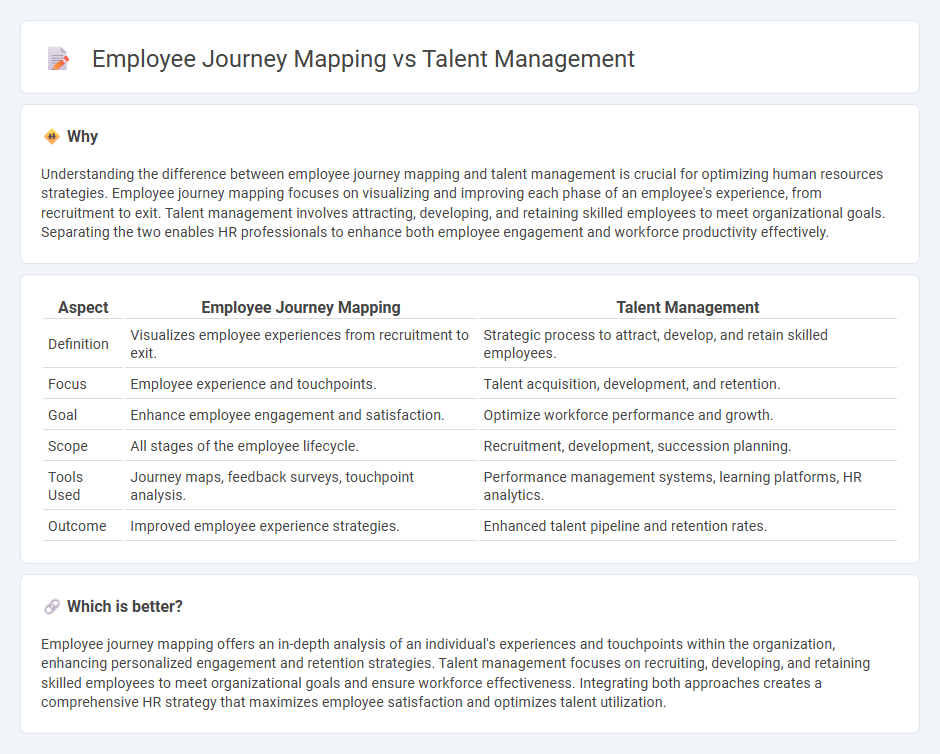
Employee journey mapping focuses on visualizing and analyzing every interaction an employee has within an organization to enhance engagement and retention. Talent management involves strategic acquisition, development, and retention of skilled employees to drive organizational success. Explore the differences and benefits of each to optimize your HR strategy.
Why it is important
Understanding the difference between employee journey mapping and talent management is crucial for optimizing human resources strategies. Employee journey mapping focuses on visualizing and improving each phase of an employee's experience, from recruitment to exit. Talent management involves attracting, developing, and retaining skilled employees to meet organizational goals. Separating the two enables HR professionals to enhance both employee engagement and workforce productivity effectively.
Comparison Table
| Aspect | Employee Journey Mapping | Talent Management |
|---|---|---|
| Definition | Visualizes employee experiences from recruitment to exit. | Strategic process to attract, develop, and retain skilled employees. |
| Focus | Employee experience and touchpoints. | Talent acquisition, development, and retention. |
| Goal | Enhance employee engagement and satisfaction. | Optimize workforce performance and growth. |
| Scope | All stages of the employee lifecycle. | Recruitment, development, succession planning. |
| Tools Used | Journey maps, feedback surveys, touchpoint analysis. | Performance management systems, learning platforms, HR analytics. |
| Outcome | Improved employee experience strategies. | Enhanced talent pipeline and retention rates. |
Which is better?
Employee journey mapping offers an in-depth analysis of an individual's experiences and touchpoints within the organization, enhancing personalized engagement and retention strategies. Talent management focuses on recruiting, developing, and retaining skilled employees to meet organizational goals and ensure workforce effectiveness. Integrating both approaches creates a comprehensive HR strategy that maximizes employee satisfaction and optimizes talent utilization.
Connection
Employee journey mapping identifies key touchpoints and experiences throughout the workforce lifecycle, providing critical insights for effective talent management strategies. By analyzing these insights, organizations can tailor recruitment, development, and retention initiatives to align with employee needs and organizational goals. This integration enhances employee engagement, reduces turnover, and drives overall workforce productivity.
Key Terms
Talent Management:
Talent management encompasses attracting, developing, and retaining skilled employees to optimize organizational performance and drive business success. It involves strategic processes such as recruitment, onboarding, learning and development, performance management, and succession planning, all aimed at maximizing employee potential and aligning talent with company goals. Explore further to understand how talent management can transform workforce capabilities and boost competitiveness.
Succession Planning
Talent management encompasses the strategic process of identifying, developing, and retaining high-potential employees to ensure seamless succession planning in key organizational roles. Employee journey mapping visualizes the entire employee experience to pinpoint moments critical for growth and retention, enhancing succession outcomes by aligning development opportunities with career milestones. Explore how integrating these approaches optimizes succession planning and strengthens leadership pipelines.
Performance Management
Talent management centers on attracting, developing, and retaining top performers to enhance organizational success, emphasizing performance appraisals, goal setting, and continuous feedback. Employee journey mapping focuses on visualizing touchpoints throughout an employee's lifecycle to improve engagement and identify performance bottlenecks influencing productivity. Discover how integrating these approaches can revolutionize your performance management strategy.
Source and External Links
Talent Management: The Complete Guide - AIHR - Talent management is a comprehensive set of HR processes and strategies designed to attract, develop, motivate, and retain high-performing employees to drive organizational performance through integrated people management practices.
Talent Management - OPM - Talent management ensures organizations place the right people with the right skills in the right positions at the right time by planning workforce needs, closing skills gaps, and implementing strategies for attracting, developing, and retaining diverse, high-quality talent.
Talent Management - What Is It & Why Is It Important? - ADP - Talent management includes workforce planning, recruitment, onboarding, training, development, engagement, performance monitoring, and recognition to build a productive workforce likely to remain with the organization while improving business performance and competitiveness.
 dowidth.com
dowidth.com